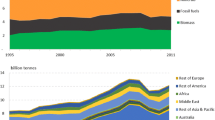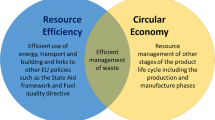Abstract
Due to the global fragmentation of supply and use chains, final consumption and the production of goods and services are often spatially disconnected. A country in which a large share of material and energy use is dedicated to the production of exports may seem to consume more material than a country that imports material-intensive products. Material flow accounting (MFA) is a well-established tool within environmental accounting, and the indicators it provides are increasingly used to inform policy-making on sustainability issues. Growing trade volumes and the deeper integration of all economies into global markets have posed a new challenge to MFA: how can we expand the scope of the accounts from a production-based perspective to one that includes consumption? In this chapter, we discuss the recent additions to the MFA method that seek to allocate material use to those economies where final consumption occurs rather than to those economies producing for export. These approaches are illustrated with a case study of the Austrian economy. This case study compares material use in Austria under production- and consumption-based approaches.
Access this chapter
Tax calculation will be finalised at checkout
Purchases are for personal use only
Similar content being viewed by others
Notes
- 1.
DMC = Domestic extraction (DE) + imports − exports.
- 2.
Full coverage may be hindered by truncation decisions, which have to be made in the tracing of any life cycle. Allocation decisions can potentially lead to double-counting and must be made whenever the same production process produces more than one good. Allocation can be based on different aspects of the products (economic value, mass/energy, material input avoided by coupled (instead of single-product) production). The results of these different allocation approaches can be completely opposite, so the decision of which procedure to use has a major impact on the results.
- 3.
The category of other products had to be introduced because some of the product groups in the IO data are composed of more than one type of the four basic materials, and a dominant material cannot be unambiguously identified.
- 4.
Following MFA conventions, we accounted for metal DE as the gross ore (see Eurostat 2001).
- 5.
For the sake of clarity, we will mainly describe LCA in terms of a product. However, LCA may also be applied to well-defined processes, services or even organizations.
References
Ayres, R. U., & Kneese, A. V. (1969). Production, consumption and externalities. American Economic Review, 59(3), 282–297.
Daly, H. E. (1973). The steady-state economy: Toward a political economy of biophysical equilibrium and moral growth. In H. E. Daly (Ed.), Toward a steady-state economy (pp. 149–174). San Francisco: W.H.Freeman.
Eurostat. (2001). Economy-wide material flow accounts and derived indicators. A methodological guide. Luxembourg: Eurostat, European Commission, Office for Official Publications of the European Communities.
Eurostat. (2007). Economy-wide material flow accounting. A Compilation Guide. Luxembourg: European Statistical Office.
Eurostat. (2009). Economy wide material flow accounts. Compilation guidelines for reporting to the 2009 Eurostat questionnaire (Version 01 – June 2009). Luxembourg: European Statistical Office.
Fischer-Kowalski, M., & Amann, C. (2001). Beyond IPAT and Kuznets curves: Globalization as a vital factor in analysing the environmental impact of socio-economic metabolism. Population and Environment, 23(1), 7–47.
Fischer-Kowalski, M., & Weisz, H. (1999). Society as a hybrid between material and symbolic realms. Toward a theoretical framework of society-nature interaction. Advances in Human Ecology, 8, 215–251.
Meadows, D. L., Meadows, D. H., & Randers, J. (1972). The limits to growth. New York: Universe Books.
Peters, G. P., Minx, J. C., Weber, C. L., & Edenhofer, O. (2011). Growth in emission transfers via international trade from 1990 to 2008. Proceedings of the National Academy of Sciences, 108(21), 8903–8908.
Schaffartzik, A., Eisenmenger, N., Krausmann, F., & Weisz, H. (2014). Consumption-based material flow accounting: Austrian trade and consumption in raw material equivalents (RME) 1995–2007. Journal of Industrial Ecology, 18(1), 102–112.
Statistik Austria. (2011). Materialflussrechnung (Material Flow Accounting). Statistik Austria. http://www.statistik.at/web_de/statistiken/energie_und_umwelt/umwelt/materialflussrechnung/index.html. Accessed 09/2013.
Statistik Austria. (2012). STATcube Statistical Database. Statistik Austria. http://www.statistik.at/web_de/services/datenbank_superstar/index.html. Accessed 09/2013.
Suh, S., Lenzen, M., Treloar, G. J., Hondo, H., Horvath, A., Huppes, G., et al. (2003). System boundary selection in life-cycle inventories using hybrid approaches. Environmental Science and Technology, 38(3), 657–664.
WTO. (2008). World trade report 2008: Trade in a globalizing world. Geneva: World Trade Organization (WTO).
References
Baumann, H., & Tillmann, A. M. (2004). The Hitch Hiker’s guide to LCA. An orientation in life cycle assessment methodology and application. Lund: Studentlitteratur.
Finkbeiner, M., Inaba, A., Tan, R. B. H., Christiansen, K., & Klüppel, H.-J. (2006). The new International standards for life cycle assessment: ISO 14040 and ISO 14044. International Journal of Life Cycle Assessment, 11, 80–85.
Finnveden, G., Hauschild, M. Z., Ekvall, T., Guinée, J., Heijungs, R., Hellweg, S., et al. (2009). Recent developments in life cycle assessment. Journal of Environmental Management, 91, 1–21.
JRC. (2013). Introduction to LCA, Figure: Scheme of a product system’s life cycle with data collection of product and waste flows (blue lines) and resources (green) and emissions (grey arrows) followed by the impact assessment of the emissions and resource consumption. Available from http://lca.jrc.ec.europa.eu/lcainfohub/introduction.vm. Accessed October 10, 2013.
Pelletier, N. L., Ayer, N. W., Tyedmers, P. H., Kruse, S. A., Flysjo, A., Robillard, G., et al. (2007). Impact categories for life cycle assessment research of seafood production systems: Review and prospectus. International Journal of Life Cycle Assessment, 12, 414–421.
Roy, P., Nei, D., Orikasa, T., Xu, Q., & Okadome, H. (2009). A review of life cycle assessment (LCA) on some food products. Journal of Food Engineering, 90, 1–10.
Theurl, M. C., Haberl, H., Erb, K.-H., & Lindenthal, T. (2014). Contrasted greenhouse gas emissions from local versus long-range tomato production. Agronomy for Sustainable Development, 34, 593–602. doi:10.1007/s13593-013-0171-8.
References
Lenzen, M. (2001). A generalized input-output multiplier calculus for Australia. Economic Systems Research, 13(1), 65–92.
Leontief, W. (1986). Input-output economics. New York, Oxford: Oxford University Press.
Peters, G., & Hertwich, E. (2008). CO2 embodied in International trade with implications for global climate policy. Environmental Science & Technology, 42(5), 1401–1407.
Author information
Authors and Affiliations
Corresponding author
Editor information
Editors and Affiliations
Rights and permissions
Copyright information
© 2016 Springer International Publishing Switzerland
About this chapter
Cite this chapter
Schaffartzik, A., Eisenmenger, N., Wiedenhofer, D. (2016). Boundary Issues: Calculating National Material Use for a Globalized World. In: Haberl, H., Fischer-Kowalski, M., Krausmann, F., Winiwarter, V. (eds) Social Ecology. Human-Environment Interactions, vol 5. Springer, Cham. https://doi.org/10.1007/978-3-319-33326-7_10
Download citation
DOI: https://doi.org/10.1007/978-3-319-33326-7_10
Published:
Publisher Name: Springer, Cham
Print ISBN: 978-3-319-33324-3
Online ISBN: 978-3-319-33326-7
eBook Packages: Earth and Environmental ScienceEarth and Environmental Science (R0)




